| Contents
Home
General
Info
Ordering
Info
Contact us
Cartridge
Lists
Patent & Miscellaneous
Rim Fire
Center Fire Pistol
Center Fire Rifle
Metric Rimfire,
Pistol&Rifle
British Pistol and Rifle
Shotgun Shells
Cartridge Boxes &
Related
Posters
This Month's Picture Page
Index to
Picture Pages
Prior Picture Pages:
*
September 2003
*
October 2003
*
November 2003
*
December 2003
*
January 2004
*
February 2004
*
March 2004
*
April 2004
*
May 2004
*
June 2004
*
July 2004
*
August 2004
*
September 2004
*
October 2004
*
November 2004
*
December
2004
*
January 2005
*
February
2005
*
March
2005
*
April
2005
*
May 2005
* June 2005
* July 2005
*
August 2005
*
September
2005
*
October 2005
*
November 2005
*
December 2005
*
January 2006
*
February 2006
*
March 2006
*
April 2006
*May 2006
*June 2006
*July 2006
*August
2006
*September
2006
*October
2006
*November
2006
*December
2006
*January
2007
*February
2007
*March
2007
*April
2007
*May
2007
*June
2007
*July
2007
*August
2007
*September
2007
*October
2007
*November
2007
*December
2007
*January
2008
*February
2008
*March
2008
*April
2008
*May
2008
*June
2008
*July
2008
*August
2008
*September
2008
*October
2008
*November
2008
*December
2008
*January
2009
Links to Other Sites
Cartridge Collectors Organizations:
IAA
ECRA
SAAACA
Auctions:
Auction
Arms
E-Bay
Ward's Collectibles
Sold USA
Books:
Armory
Publications
WCF Publications
Other Collector's Sites:
Curtis Steinhauer
|
Home of the Old Ammo Guy's Virtual
Cartridge Trading Table
Featuring a wide range of antique,
obsolete, and modern ammunition for collectors
Picture
Page
February 2009
An early and uncommon gun powder can .......
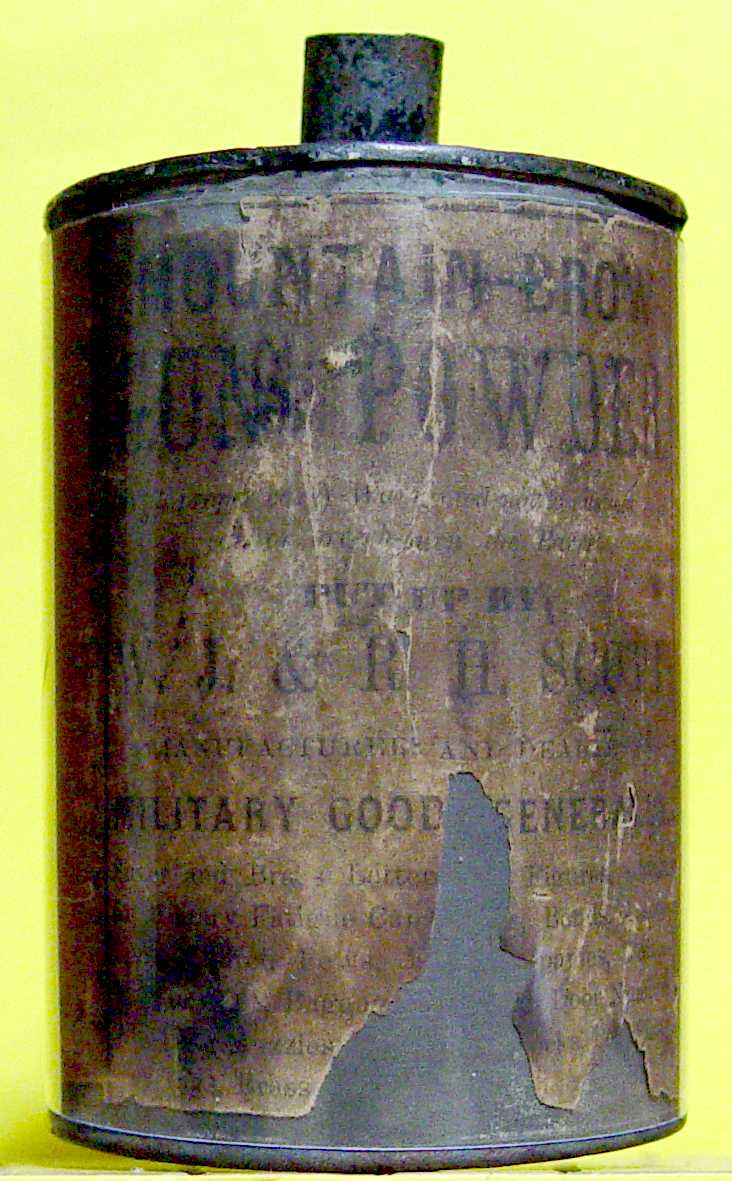 Here
is an unusual gun powder can, intended as a promotional sample for
advertising the military, shooting, and general sporting goods and services
offered by the retailers W.J. & R.H. Scott of Albany, New York.. The
Scotts were were the brothers William J. and Richard H. Scott.
They began as gunsmiths at 3 Beaver Street in 1845; sometime around 1850,
they moved a few doors down to 9 Beaver Street, and were advertising
themselves as dealers in guns and military goods. The label on the can shows
their address as 60 State Street, 'at the sign of the BIG PISTOL', where
they were located from about 1862 until William's death in 1871, at which
time Richard assumed sole ownership of the business. He remained at 60 State
Street until 1878, when he moved to 8 James Street, selling guns and
military equipment there until his death in 1881. All four of the business
locations were in close proximity to the Hudson River and the eastern
terminus Here
is an unusual gun powder can, intended as a promotional sample for
advertising the military, shooting, and general sporting goods and services
offered by the retailers W.J. & R.H. Scott of Albany, New York.. The
Scotts were were the brothers William J. and Richard H. Scott.
They began as gunsmiths at 3 Beaver Street in 1845; sometime around 1850,
they moved a few doors down to 9 Beaver Street, and were advertising
themselves as dealers in guns and military goods. The label on the can shows
their address as 60 State Street, 'at the sign of the BIG PISTOL', where
they were located from about 1862 until William's death in 1871, at which
time Richard assumed sole ownership of the business. He remained at 60 State
Street until 1878, when he moved to 8 James Street, selling guns and
military equipment there until his death in 1881. All four of the business
locations were in close proximity to the Hudson River and the eastern
terminus
 of
the Erie Canal, providing them ready access to transportation for receiving
and shipping goods. of
the Erie Canal, providing them ready access to transportation for receiving
and shipping goods.
The
can is quite small, as this picture taken next to a .45-70 cartridge shows,
measuring 4" tall to the top of the spout and 2 3/8" in diameter. It is made
of tin, with soldered seams. The top was painted black, now mostly worn off,
and a cork would have sealed the spout. The label is oil soaked and stained.
and small pieces are now missing, but it is still legible. It reads as
follows:
MOUNTAIN – BROW
GUN POWDER
(With proper
care) Warranted not to rust-eat, acid- eat, or breech-burn the Barrels. PUT
UP BY W.J & R.H SCOTT MANUFACTURERS AND DEALERS IN MILITARY GOODS GENERALLY,
Silver and Brass Letters, Numbers, Figures suitable for Military Fatigue
Caps ???s Bands, Associations, Church Pews, Fire Companies, Porters Hats or
Caps, Baggage ???d Door Numbers. Also, Dog Muzzles, ???Locks, Belt Plates,
Key Tags, Brass ??? We are Mechanics at our business, and warrant all the
goods that we manufacture. We warrant all out Gun repairing - should any of
it fail within a reasonable length of time, we will do it over without
charge. We examine and complete in our own factory all our English and Dutch
guns before offering them for sale, and when sold, we will warrant them to
shoot well, and in case they do not, will return the money. Repairing done
at short notice We take the greatest care in making up Patent Muzzle and
Hunting Rifles. We warrant them to be better made and to shoot better, than
any other Gun of similar styles and dimensions manufactured in this country.
We also deal in CHEMICAL OIL For Oiling Rifles, Fouling Guns, Pistols, and
Locks, to prevent the acid absorbed from the powder from eating the metal.
It is the best oil ever used for this purpose. Also, Swords, Sashes, Sword
Belts, Military and Navy buttons Gold and silver Lace, Gold and Silver
Tassels, Fire and Exhibition Speaking Trumpets, American Flags, Sword Canes,
Dirks, Bowie Knives, Poignards, Stilettos, Hunting Knives, Fish Poles, Hooks
and Lines, Stencil Plates, Dog Whips, ??? Flasks, Wad Cutters, Shot Pouches
and Belts, Powder Flasks, Dog Leads, Game Bags, Decoy Ducks, &c. DOUBLE AND
SINGLE FOWLING GUNS Rifles and Smooth-Bores, Pistols, Powder, Shot, Caps,
Gun Boxes, Silver, German Silver and Brass, Dog Collars, Cane Ferrules,
Canes Mounted to order and Sporting Apparatus manufactured and sold at the
Gun Warehouse. No. 60 State St, Albany, N. Y. At the sign of the BIG
PISTOL.
A smaller R.H. Scott can, just 2" tall, is pictured in Gun Powder Cans &
Kegs (by Ted and David Bacyk, and Tom Rowe). While they indicate a circa
1860s date for their can, it would have been made after 1871, when Richard
Scott was running the business by himself. The portion of the label
that is visible in the photo of this can reads:
AGENT FOR THE DUPONT POWDER CO. AND DEALER IN Sporting Apparatus,
Generally, At The Sign Of The Gilt Cartridge 60 STATE ST. Gen.
Pistol and Sword Repairing
This can probably has similar wording to what is on my can on the
remainder of the label.
.
.
A box of .32 New Police mid-range cartridges...........
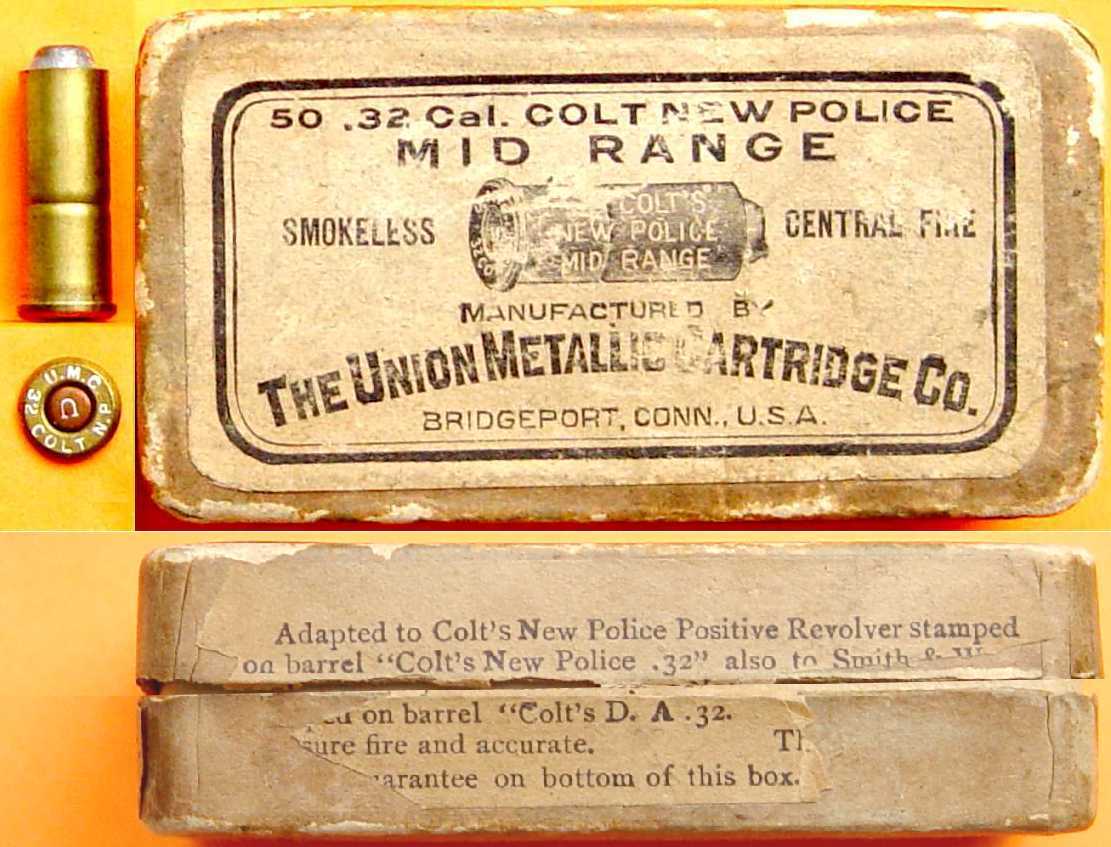 While
I occasionally see individual mid-range cartridges with deep-seated bullets
in a variety of pistol calibers, I don't often see a full box of the
cartridges. The Union Metallic Cartridge Company produced the .32 Colt New
Police cartridge over nearly a 16 year period, from shortly after the
cartridge was introduced by Colt in 1896, until about 1912, when the company
merged with Remington. The relative lack of mid-range boxes and cartridges
would suggest that it was not a big seller. The .32 Colt New Police is one
of several cartridges introduced by Colt that involved simply loading a flat
nose bullet in a case that was developed by their competitor Smith & Wesson,
and then giving it a Colt name. In this case, the .32 S&W Long case was
used. Other examples include the .38 Colt New Police (used the .38 S&W case)
and the .38 Colt Special (.38 While
I occasionally see individual mid-range cartridges with deep-seated bullets
in a variety of pistol calibers, I don't often see a full box of the
cartridges. The Union Metallic Cartridge Company produced the .32 Colt New
Police cartridge over nearly a 16 year period, from shortly after the
cartridge was introduced by Colt in 1896, until about 1912, when the company
merged with Remington. The relative lack of mid-range boxes and cartridges
would suggest that it was not a big seller. The .32 Colt New Police is one
of several cartridges introduced by Colt that involved simply loading a flat
nose bullet in a case that was developed by their competitor Smith & Wesson,
and then giving it a Colt name. In this case, the .32 S&W Long case was
used. Other examples include the .38 Colt New Police (used the .38 S&W case)
and the .38 Colt Special (.38 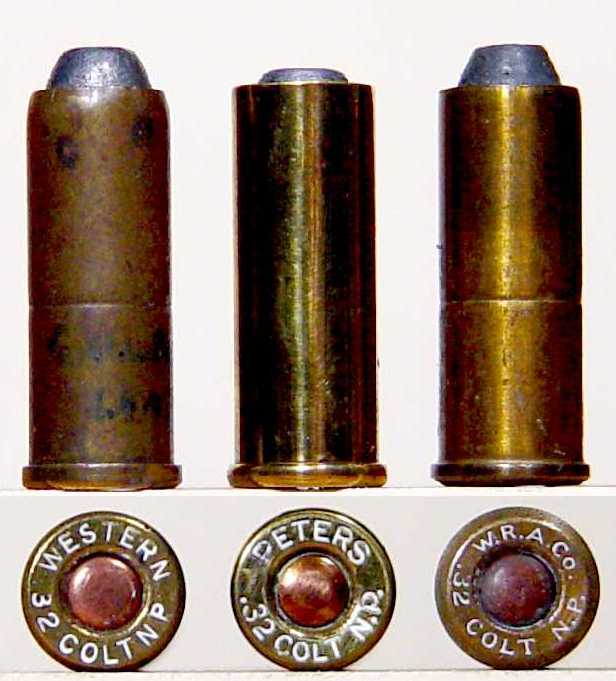 S&W
Special). The cartridges in the box are loaded with smokeless powder as
noted on the label; the cannelure (groove) in the cartridge case and its 'U'
marked primer are also indicators of a smokeless load. S&W
Special). The cartridges in the box are loaded with smokeless powder as
noted on the label; the cannelure (groove) in the cartridge case and its 'U'
marked primer are also indicators of a smokeless load.
This next picture shows three variations of the .32 Colt New Police
mid-range cartridge as made by Western, Peters, and Winchester. The Peters
example is probably a black powder load, as indicated by the absence of a
cannelure in the case.
.
.
.
.
.
A progression of .270 Weatherby Magnum
boxes.........
Weatherby cartridge cases and loaded ammunition have been
produced by a number of different companies over the years. Roy Weatherby
initially used Winchester-made 300 H&H cases which he fire-formed for his
line of cartridges, and then loaded himself. A contract with Speer in
1952 to supply cases failed due to their inability to produce the quality
and quantity of cases required by Roy Weatherby. In 1953, Weatherby
contracted with the Swedish ammunition firm Norma to produce his cases,
which he loaded himself; eventually, Norma began producing loaded Weatherby
ammunition. This arrangement went well, but in 1963 Weatherby's partner sold
his half interest in the company to the German companies J.P Sauer and
Dynamit-Nobel, at which time the German director of those companies decided
that RWS should be producing the ammunition and immediately canceled the
contract with Norma without informing Roy Weatherby of his decision. This
resulted in a shortage of Weatherby ammunition for a period as the German
company tooled up for production. After three years or so of problems with
ammunition and rifle production caused by the poor management of his German
partners, Weatherby was successful in arranging a buyout of their interest
in his company in 1966, and soon after, the relationship with Norma was
renewed.
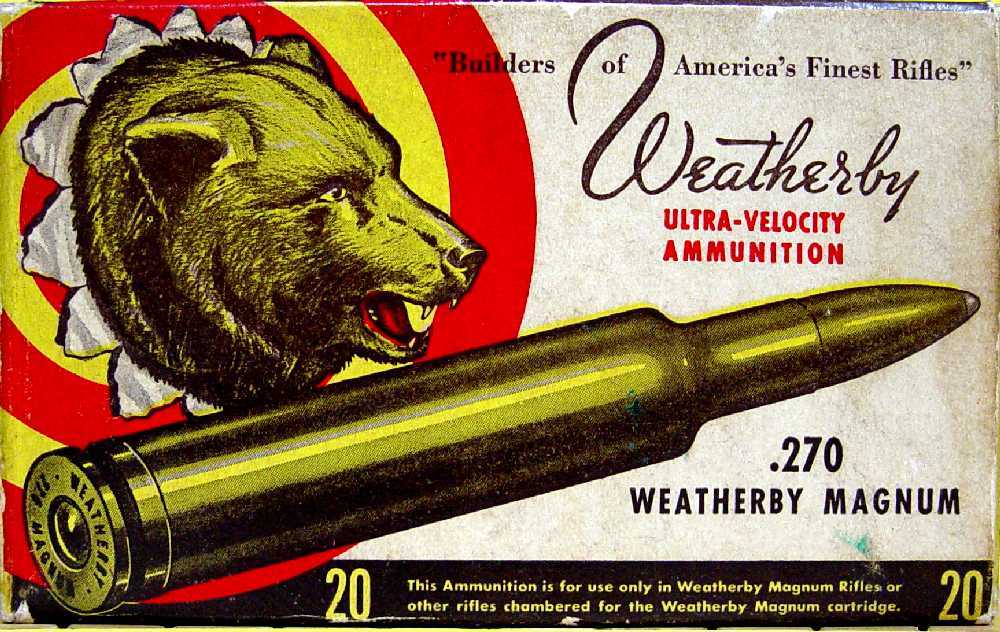 Over
the last few months, I have picked up eighteen .270 Weatherby Magnum boxes
from several sources through no real conscious effort on my part. What I
found surprising while looking through them was that there were ten
variations among the eighteen boxes, not counting load variations. I believe
the oldest box is the one above with the bear bursting through a target.
Printed on the lower left corner of the back of the box is 'Brass made in
Sweden', indicating that this box Over
the last few months, I have picked up eighteen .270 Weatherby Magnum boxes
from several sources through no real conscious effort on my part. What I
found surprising while looking through them was that there were ten
variations among the eighteen boxes, not counting load variations. I believe
the oldest box is the one above with the bear bursting through a target.
Printed on the lower left corner of the back of the box is 'Brass made in
Sweden', indicating that this box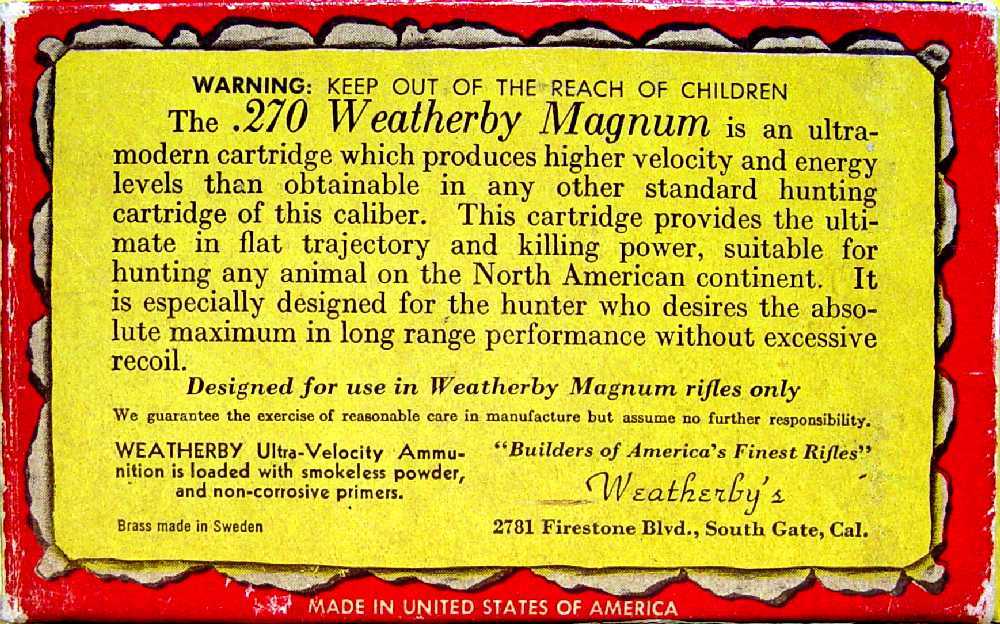 holds cartridges that were loaded by Roy Weatherby in South Gate,
California, using cases that were made by Norma. The box includes the 'Keep
out of reach of children warning that was mandated by the US government
in 1962; this would suggest that the box was made in 1962 or shortly
thereafter. The cartridges in this box have unmarked nickel
primers with green sealant; the headstamp is WEATHERBY .270 MAGNUM.
holds cartridges that were loaded by Roy Weatherby in South Gate,
California, using cases that were made by Norma. The box includes the 'Keep
out of reach of children warning that was mandated by the US government
in 1962; this would suggest that the box was made in 1962 or shortly
thereafter. The cartridges in this box have unmarked nickel
primers with green sealant; the headstamp is WEATHERBY .270 MAGNUM.
Fourteen of my boxes are the more commonly encountered 'tiger' format,
which have a 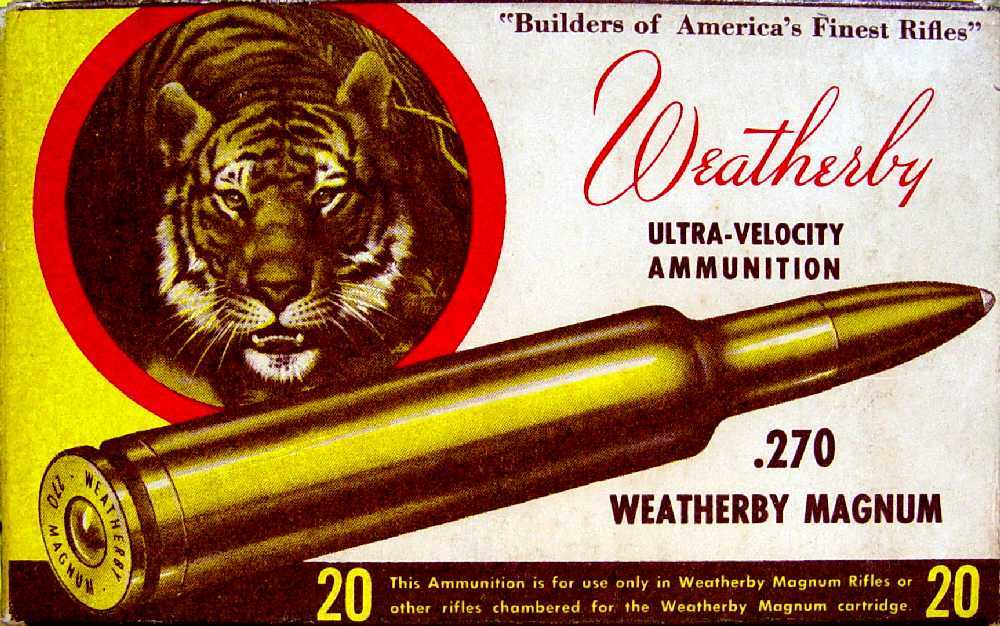 Bengal
tiger head framed in a red circle on the front label, as shown in this
picture. In addition to the tiger, Weatherby in script, and the
cartridge on the label, it includes the advisory 'This Ammunition is for use
only in Weatherby Magnum Rifles or other rifles chambered for the Weatherby
Magnum cartridge'. The cartridges in a fourteen tiger boxes have the same
headstamp as those in the bear box discussed above. Eleven of the boxes the
exact same front as shown here, Bengal
tiger head framed in a red circle on the front label, as shown in this
picture. In addition to the tiger, Weatherby in script, and the
cartridge on the label, it includes the advisory 'This Ammunition is for use
only in Weatherby Magnum Rifles or other rifles chambered for the Weatherby
Magnum cartridge'. The cartridges in a fourteen tiger boxes have the same
headstamp as those in the bear box discussed above. Eleven of the boxes the
exact same front as shown here,
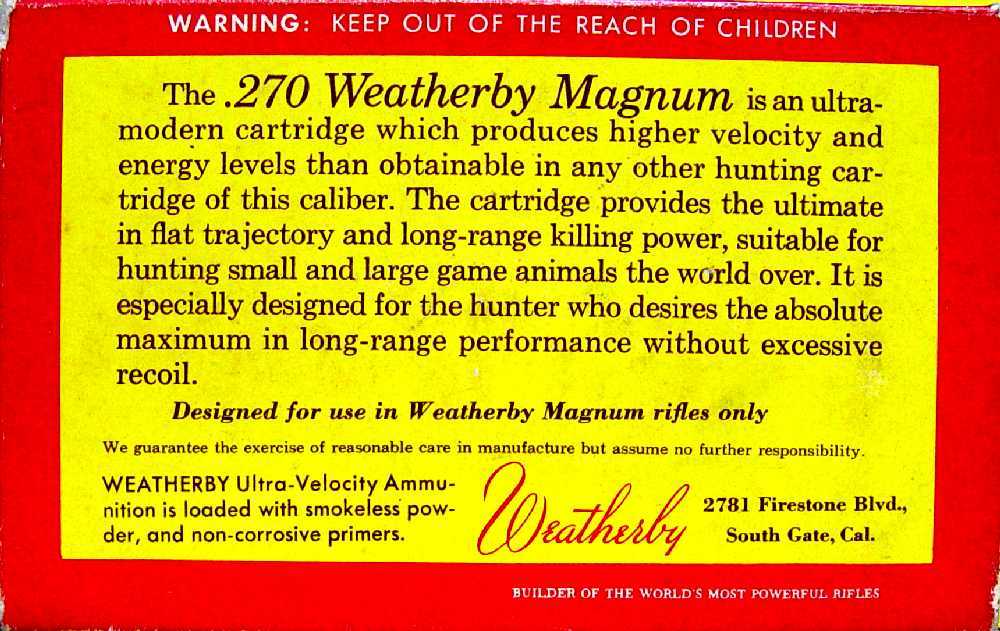 but
five variations in the back labels were found among these. The basic tiger
box back label is as shown in this picture which, like the bear box above,
includes the Weatherby address as 2791 Firestone Blvd, South Gate,
California, as do all of the fourteen of the tiger boxes. Nothing is printed
on the back of this box to indicate where the ammunition or cases were made,
however, the cartridges have nickel primers with green sealant, which
appears to be the standard for cartridges but
five variations in the back labels were found among these. The basic tiger
box back label is as shown in this picture which, like the bear box above,
includes the Weatherby address as 2791 Firestone Blvd, South Gate,
California, as do all of the fourteen of the tiger boxes. Nothing is printed
on the back of this box to indicate where the ammunition or cases were made,
however, the cartridges have nickel primers with green sealant, which
appears to be the standard for cartridges
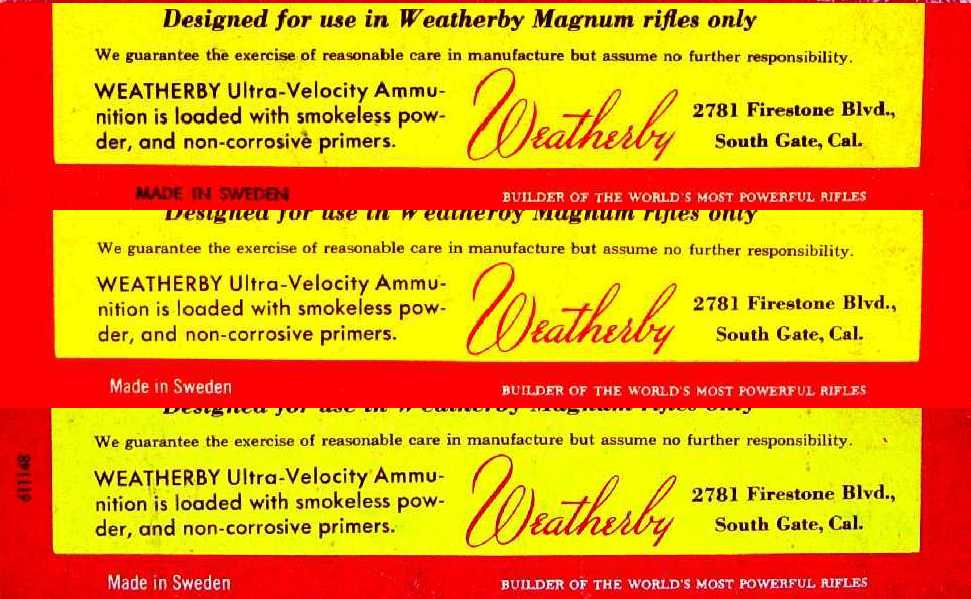 made by Norma. made by Norma.
This picture is a composite of the lower portions of the back labels on
three of the boxes that are marked 'Made in Sweden, indicating
production by Norma. On the first one, the printing is in black, on the
second, it is in white as it is on the third, with the addition of a black
product code 611148. The cartridges in the two upper boxes without the
product code are headstamped WEATHERBY .270 MAGNUM and have nickel
primers with green sealant. The box with the product code has cartridges
with a mix of WEATHERBY .270 MAGNUM and WEATHERBY 270WBY MAG
headstamps, all with brass primers and green sealant. I don't know one or
the other of the headstamps is original to the box, or if it originally held
the mixed headstamps.
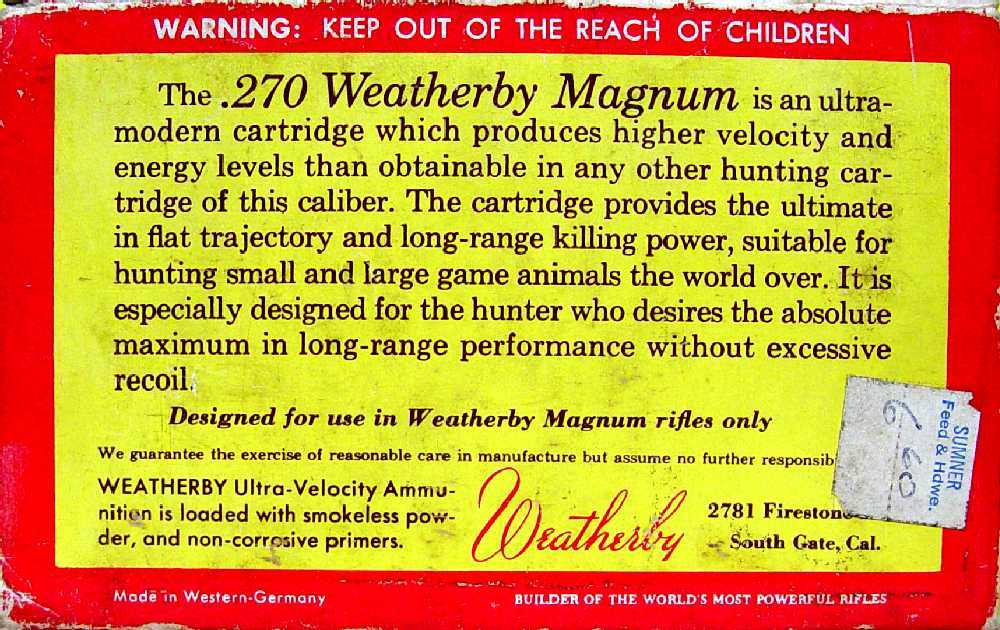 This
picture shows the back of one of the boxes produced during the short period
in the early 1960s by RWS. It is marked on the lower left 'Made in Western
Germany. Otherwise, the box is the same as the other tiger boxes discussed
so far. The cartridges are headstamped WEATHERBY .270 MAGNUM and have
nickel primers marked RWS with red sealant. This
picture shows the back of one of the boxes produced during the short period
in the early 1960s by RWS. It is marked on the lower left 'Made in Western
Germany. Otherwise, the box is the same as the other tiger boxes discussed
so far. The cartridges are headstamped WEATHERBY .270 MAGNUM and have
nickel primers marked RWS with red sealant.
The markings on these tiger boxes (and the bear box) should provide clues
as to about when they were made.
Zip codes were introduced in 1963, and most companies were quick to adopt
them. The 'Keep out of reach of children' warning was required by the
government in 1962. All of the boxes shown so far have the warning; this,
coupled with their lack of a zip code, should indicate that all were
probably produced in or shortly after 1962. However, at about the
time that Weatherby cartridge production was being shifted to Germany, some
time in 1963, zip codes should have appeared on the boxes. Its possible that
the Germany marked box above was made prior to Roy Weatherby knowing what
his zip code would be, but more than likel;y, he or the printer overlooked
it on the earlier boxes. As the zip code was not required by law to be on
the boxes, Weatherby would not have been inclined to scrap perfectly good
boxes, and may have continued to use these boxes well into the 1960s.
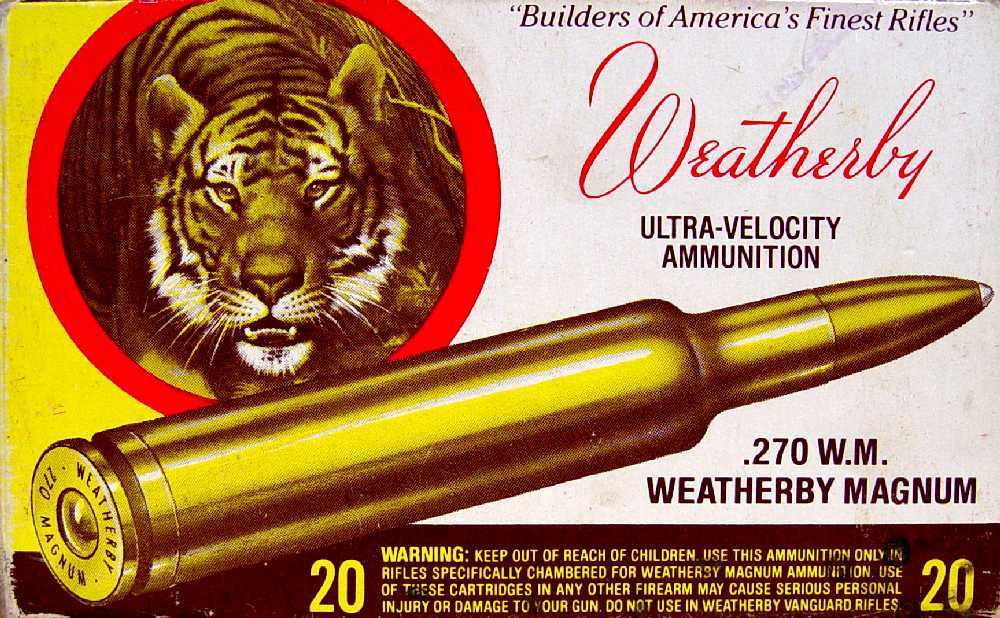 Two
additional variations of the tiger box were in the group, both with changes
to the fronts as well as the backs. Both are marked 'Made in Sweden', and
were produced following the the transfer back to Norma from RWS. The caliber
designation on the front of both has been revised by adding 'W.M.' after
the .270 on the first box, shown here, and then removing the 'Weatherby
Magnum' but including the W.M. on the second box shown below. The warning on
the lower front of each box is also changed, to include the 'Keep out of the
reach of children' warning, and a revision of the wording that appeared on
earlier boxes about using the ammunition only in rifles chambered for Weatherby
ammunition. In addition, the box above includes a warning to
not use the ammunition in Weatherby Vanguard rifles. This was added at about
the time Two
additional variations of the tiger box were in the group, both with changes
to the fronts as well as the backs. Both are marked 'Made in Sweden', and
were produced following the the transfer back to Norma from RWS. The caliber
designation on the front of both has been revised by adding 'W.M.' after
the .270 on the first box, shown here, and then removing the 'Weatherby
Magnum' but including the W.M. on the second box shown below. The warning on
the lower front of each box is also changed, to include the 'Keep out of the
reach of children' warning, and a revision of the wording that appeared on
earlier boxes about using the ammunition only in rifles chambered for Weatherby
ammunition. In addition, the box above includes a warning to
not use the ammunition in Weatherby Vanguard rifles. This was added at about
the time
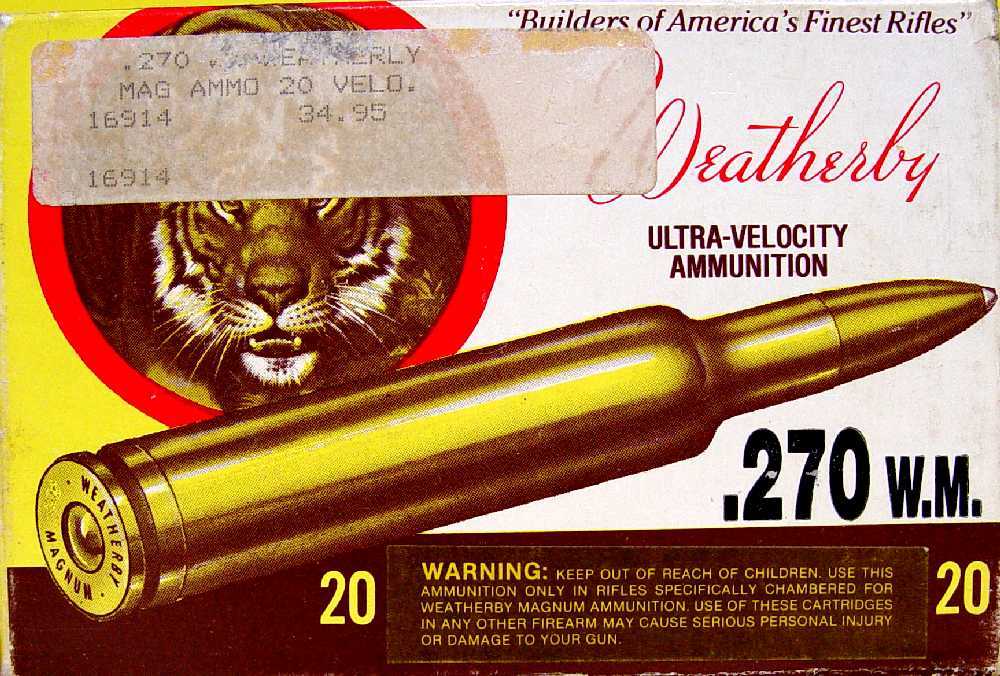 Weatherby
began production of the Vanguard action in 1970. This new action had only
two locking lugs for the bolt, compared with the 9 lugs on the Mark V
action. This reduced number of lugs resulted in a weaker action, and the
need to warn against shooting ammunition intended for the Mark V rifle in
the Vanguard. Later style boxes do not mention the Vanguard, so either they
strengthened the action or made a change in the ammunition. On the second
box, there is an added label with the warning information. I don't know what
was originally printed on the box beneath this label, and can't say which of
these two boxes was made later, but I suspect it was this second one. Weatherby
began production of the Vanguard action in 1970. This new action had only
two locking lugs for the bolt, compared with the 9 lugs on the Mark V
action. This reduced number of lugs resulted in a weaker action, and the
need to warn against shooting ammunition intended for the Mark V rifle in
the Vanguard. Later style boxes do not mention the Vanguard, so either they
strengthened the action or made a change in the ammunition. On the second
box, there is an added label with the warning information. I don't know what
was originally printed on the box beneath this label, and can't say which of
these two boxes was made later, but I suspect it was this second one.
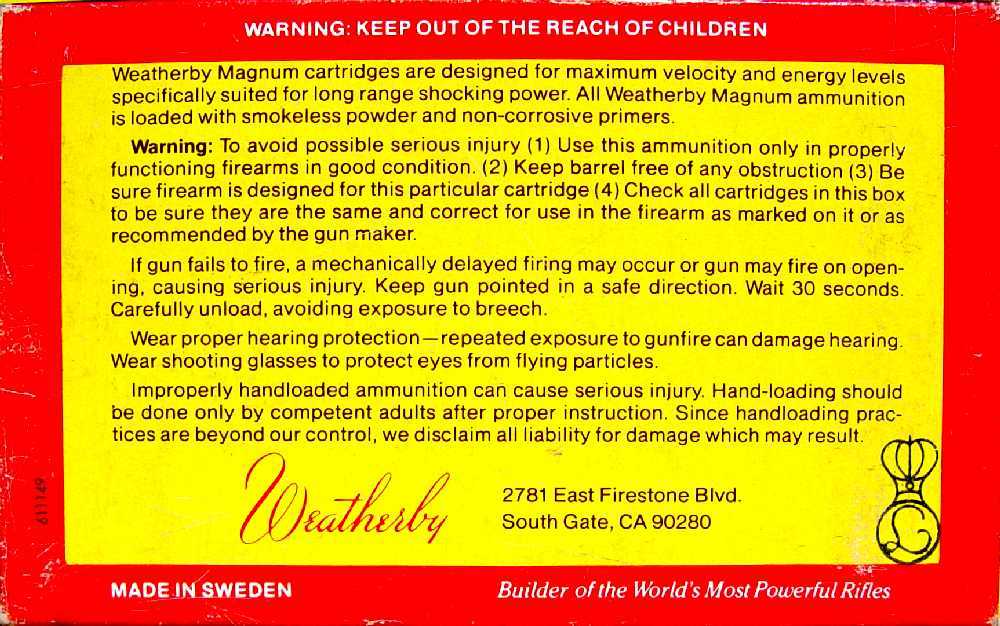 The
backs of these two boxes are shown here in the same order as their fronts
are shown above. Other than the format of the company address, they are
matching. They have been completely reworded, with additional warnings and
advice, obviously put there for purposes of reducing company liability in
the event someone considers suing for injuries resulting from their failure
to follow the basic, common-sense rules of shooting. Both display the zip
code in the company address, and both have the Norma's 'L' in a circle with crown
logo. The
backs of these two boxes are shown here in the same order as their fronts
are shown above. Other than the format of the company address, they are
matching. They have been completely reworded, with additional warnings and
advice, obviously put there for purposes of reducing company liability in
the event someone considers suing for injuries resulting from their failure
to follow the basic, common-sense rules of shooting. Both display the zip
code in the company address, and both have the Norma's 'L' in a circle with crown
logo.
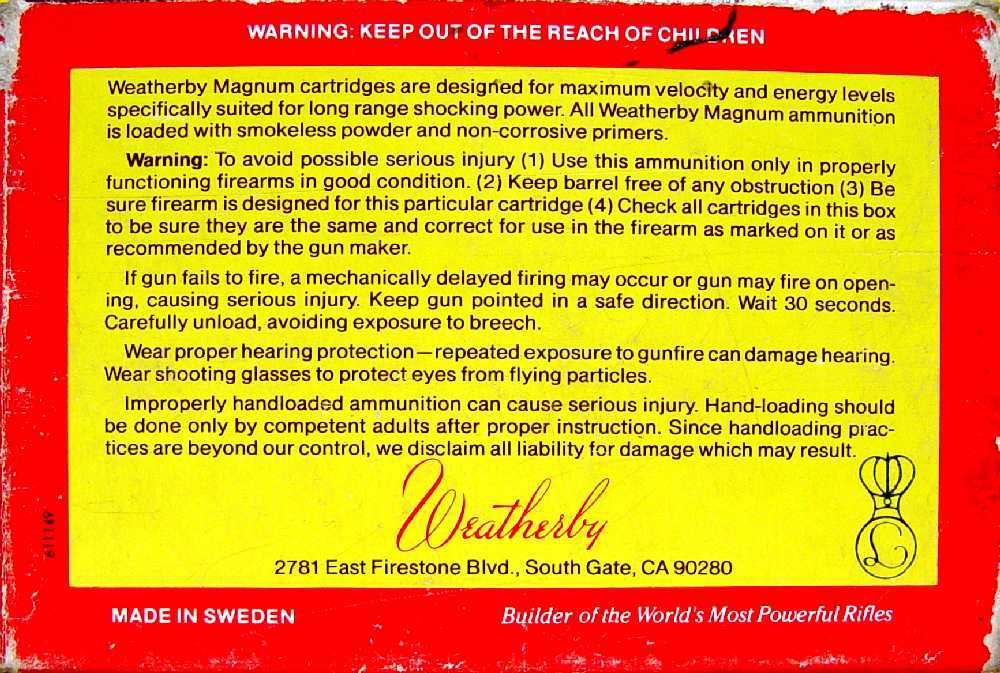
.
.
.
.
.
.
.
.
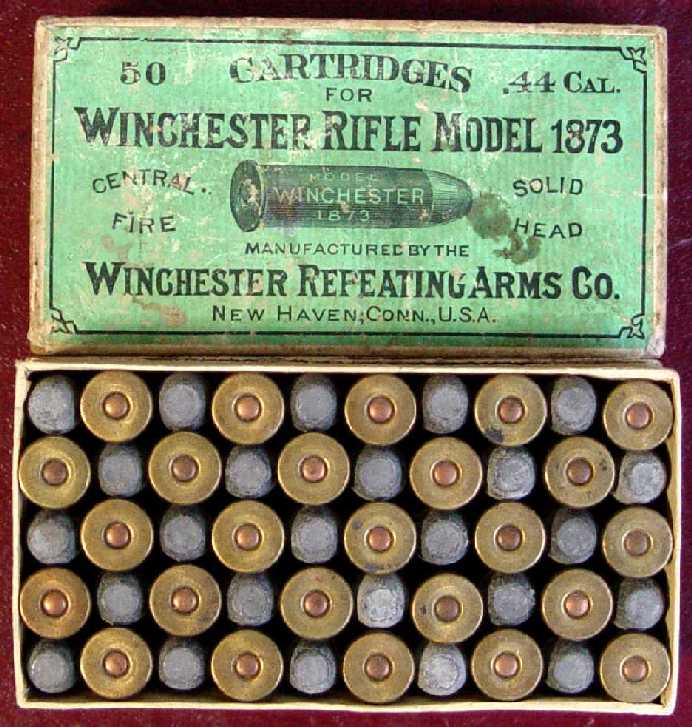
|

 Here
is an unusual gun powder can, intended as a promotional sample for
advertising the military, shooting, and general sporting goods and services
offered by the retailers W.J. & R.H. Scott of Albany, New York.. The
Scotts were were the brothers William J. and Richard H. Scott.
They began as gunsmiths at 3 Beaver Street in 1845; sometime around 1850,
they moved a few doors down to 9 Beaver Street, and were advertising
themselves as dealers in guns and military goods. The label on the can shows
their address as 60 State Street, 'at the sign of the BIG PISTOL', where
they were located from about 1862 until William's death in 1871, at which
time Richard assumed sole ownership of the business. He remained at 60 State
Street until 1878, when he moved to 8 James Street, selling guns and
military equipment there until his death in 1881. All four of the business
locations were in close proximity to the Hudson River and the eastern
terminus
Here
is an unusual gun powder can, intended as a promotional sample for
advertising the military, shooting, and general sporting goods and services
offered by the retailers W.J. & R.H. Scott of Albany, New York.. The
Scotts were were the brothers William J. and Richard H. Scott.
They began as gunsmiths at 3 Beaver Street in 1845; sometime around 1850,
they moved a few doors down to 9 Beaver Street, and were advertising
themselves as dealers in guns and military goods. The label on the can shows
their address as 60 State Street, 'at the sign of the BIG PISTOL', where
they were located from about 1862 until William's death in 1871, at which
time Richard assumed sole ownership of the business. He remained at 60 State
Street until 1878, when he moved to 8 James Street, selling guns and
military equipment there until his death in 1881. All four of the business
locations were in close proximity to the Hudson River and the eastern
terminus
 of
the Erie Canal, providing them ready access to transportation for receiving
and shipping goods.
of
the Erie Canal, providing them ready access to transportation for receiving
and shipping goods.  Over
the last few months, I have picked up eighteen .270 Weatherby Magnum boxes
from several sources through no real conscious effort on my part. What I
found surprising while looking through them was that there were ten
variations among the eighteen boxes, not counting load variations. I believe
the oldest box is the one above with the bear bursting through a target.
Printed on the lower left corner of the back of the box is 'Brass made in
Sweden', indicating that this box
Over
the last few months, I have picked up eighteen .270 Weatherby Magnum boxes
from several sources through no real conscious effort on my part. What I
found surprising while looking through them was that there were ten
variations among the eighteen boxes, not counting load variations. I believe
the oldest box is the one above with the bear bursting through a target.
Printed on the lower left corner of the back of the box is 'Brass made in
Sweden', indicating that this box holds cartridges that were loaded by Roy Weatherby in South Gate,
California, using cases that were made by Norma. The box includes the 'Keep
out of reach of children warning that was mandated by the US government
in 1962; this would suggest that the box was made in 1962 or shortly
thereafter. The cartridges in this box have unmarked nickel
primers with green sealant; the headstamp is WEATHERBY .270 MAGNUM.
holds cartridges that were loaded by Roy Weatherby in South Gate,
California, using cases that were made by Norma. The box includes the 'Keep
out of reach of children warning that was mandated by the US government
in 1962; this would suggest that the box was made in 1962 or shortly
thereafter. The cartridges in this box have unmarked nickel
primers with green sealant; the headstamp is WEATHERBY .270 MAGNUM.  Bengal
tiger head framed in a red circle on the front label, as shown in this
picture. In addition to the tiger, Weatherby in script, and the
cartridge on the label, it includes the advisory 'This Ammunition is for use
only in Weatherby Magnum Rifles or other rifles chambered for the Weatherby
Magnum cartridge'. The cartridges in a fourteen tiger boxes have the same
headstamp as those in the bear box discussed above. Eleven of the boxes the
exact same front as shown here,
Bengal
tiger head framed in a red circle on the front label, as shown in this
picture. In addition to the tiger, Weatherby in script, and the
cartridge on the label, it includes the advisory 'This Ammunition is for use
only in Weatherby Magnum Rifles or other rifles chambered for the Weatherby
Magnum cartridge'. The cartridges in a fourteen tiger boxes have the same
headstamp as those in the bear box discussed above. Eleven of the boxes the
exact same front as shown here,
 but
five variations in the back labels were found among these. The basic tiger
box back label is as shown in this picture which, like the bear box above,
includes the Weatherby address as 2791 Firestone Blvd, South Gate,
California, as do all of the fourteen of the tiger boxes. Nothing is printed
on the back of this box to indicate where the ammunition or cases were made,
however, the cartridges have nickel primers with green sealant, which
appears to be the standard for cartridges
but
five variations in the back labels were found among these. The basic tiger
box back label is as shown in this picture which, like the bear box above,
includes the Weatherby address as 2791 Firestone Blvd, South Gate,
California, as do all of the fourteen of the tiger boxes. Nothing is printed
on the back of this box to indicate where the ammunition or cases were made,
however, the cartridges have nickel primers with green sealant, which
appears to be the standard for cartridges
 made by Norma.
made by Norma. This
picture shows the back of one of the boxes produced during the short period
in the early 1960s by RWS. It is marked on the lower left 'Made in Western
Germany. Otherwise, the box is the same as the other tiger boxes discussed
so far. The cartridges are headstamped WEATHERBY .270 MAGNUM and have
nickel primers marked RWS with red sealant.
This
picture shows the back of one of the boxes produced during the short period
in the early 1960s by RWS. It is marked on the lower left 'Made in Western
Germany. Otherwise, the box is the same as the other tiger boxes discussed
so far. The cartridges are headstamped WEATHERBY .270 MAGNUM and have
nickel primers marked RWS with red sealant.  Two
additional variations of the tiger box were in the group, both with changes
to the fronts as well as the backs. Both are marked 'Made in Sweden', and
were produced following the the transfer back to Norma from RWS. The caliber
designation on the front of both has been revised by adding 'W.M.' after
the .270 on the first box, shown here, and then removing the 'Weatherby
Magnum' but including the W.M. on the second box shown below. The warning on
the lower front of each box is also changed, to include the 'Keep out of the
reach of children' warning, and a revision of the wording that appeared on
earlier boxes about using the ammunition only in rifles chambered for Weatherby
ammunition. In addition, the box above includes a warning to
not use the ammunition in Weatherby Vanguard rifles. This was added at about
the time
Two
additional variations of the tiger box were in the group, both with changes
to the fronts as well as the backs. Both are marked 'Made in Sweden', and
were produced following the the transfer back to Norma from RWS. The caliber
designation on the front of both has been revised by adding 'W.M.' after
the .270 on the first box, shown here, and then removing the 'Weatherby
Magnum' but including the W.M. on the second box shown below. The warning on
the lower front of each box is also changed, to include the 'Keep out of the
reach of children' warning, and a revision of the wording that appeared on
earlier boxes about using the ammunition only in rifles chambered for Weatherby
ammunition. In addition, the box above includes a warning to
not use the ammunition in Weatherby Vanguard rifles. This was added at about
the time
 Weatherby
began production of the Vanguard action in 1970. This new action had only
two locking lugs for the bolt, compared with the 9 lugs on the Mark V
action. This reduced number of lugs resulted in a weaker action, and the
need to warn against shooting ammunition intended for the Mark V rifle in
the Vanguard. Later style boxes do not mention the Vanguard, so either they
strengthened the action or made a change in the ammunition. On the second
box, there is an added label with the warning information. I don't know what
was originally printed on the box beneath this label, and can't say which of
these two boxes was made later, but I suspect it was this second one.
Weatherby
began production of the Vanguard action in 1970. This new action had only
two locking lugs for the bolt, compared with the 9 lugs on the Mark V
action. This reduced number of lugs resulted in a weaker action, and the
need to warn against shooting ammunition intended for the Mark V rifle in
the Vanguard. Later style boxes do not mention the Vanguard, so either they
strengthened the action or made a change in the ammunition. On the second
box, there is an added label with the warning information. I don't know what
was originally printed on the box beneath this label, and can't say which of
these two boxes was made later, but I suspect it was this second one.  The
backs of these two boxes are shown here in the same order as their fronts
are shown above. Other than the format of the company address, they are
matching. They have been completely reworded, with additional warnings and
advice, obviously put there for purposes of reducing company liability in
the event someone considers suing for injuries resulting from their failure
to follow the basic, common-sense rules of shooting. Both display the zip
code in the company address, and both have the Norma's 'L' in a circle with crown
logo.
The
backs of these two boxes are shown here in the same order as their fronts
are shown above. Other than the format of the company address, they are
matching. They have been completely reworded, with additional warnings and
advice, obviously put there for purposes of reducing company liability in
the event someone considers suing for injuries resulting from their failure
to follow the basic, common-sense rules of shooting. Both display the zip
code in the company address, and both have the Norma's 'L' in a circle with crown
logo.
